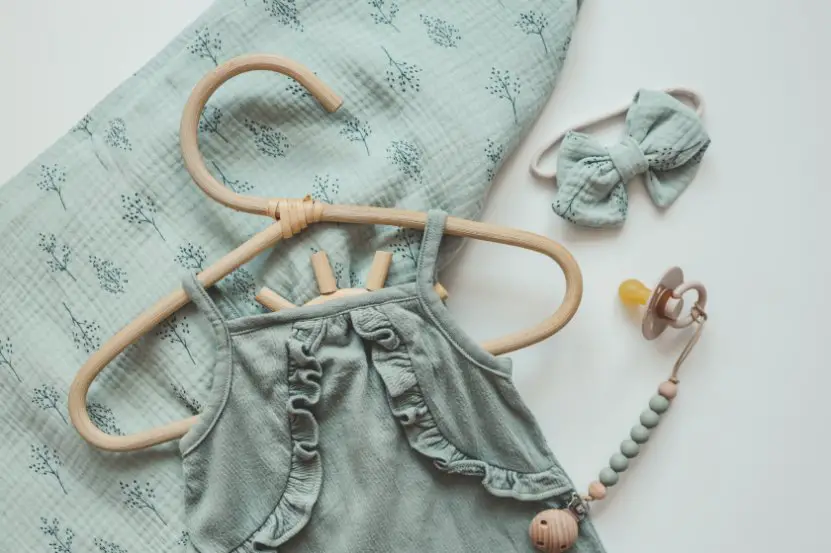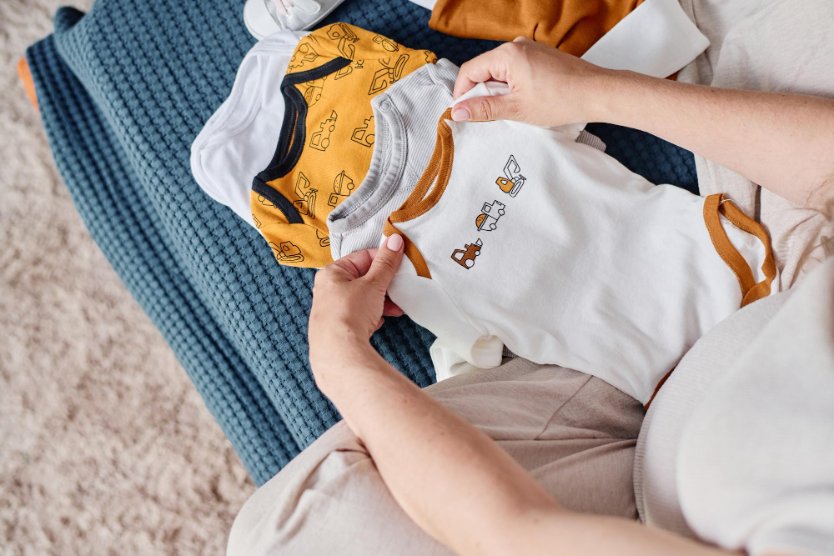Your complete guide to conscious parenting through sustainable baby fashion choices
Market Snapshot: The global organic baby clothing market reached $3.39 billion in 2024 and is projected to grow at 6.67% CAGR through 2032, making sustainable options more accessible than ever for conscious parents.
Table of Contents
- Introduction to Sustainable Baby Fashion
- Why Sustainable Fashion Matters for Newborns
- Organic and Sustainable Fabric Guide
- 2025 Design Trends and Market Insights
- Certifications and Safety Standards
- Essential Sustainable Baby Wear
- Top Sustainable Baby Clothing Brands
- Caring for Organic Baby Clothes
- Smart Shopping Strategies
- Frequently Asked Questions
- Conclusion
Welcoming a new baby brings incredible joy, and dressing them in sustainable clothing adds another layer of meaningful choice. Today’s parents are increasingly conscious about what touches their little one’s delicate skin and how their purchasing decisions impact the planet.
In 2025, sustainable newborn fashion has evolved beyond just being eco-friendly. It’s now trendy, accessible, and surprisingly diverse. The organic versus conventional debate has largely been settled, with more families choosing sustainable options for both health and environmental reasons.
2025 Sustainable Baby Fashion Market
💡 Calculate Your Environmental Impact
Want to see exactly how much water, CO2, and chemicals you can save by choosing sustainable baby clothing? Use our sustainability calculator to get personalized results based on your baby’s wardrobe needs.
Sustainable baby clothing brands are leading the way with organic materials, ethical production methods, and stylish designs that don’t compromise on planet health or baby comfort. Parents are embracing gender-neutral options, customizable pieces, and convertible clothing that grows with the baby.
The Importance of Sustainable Fashion in Newborn Apparel
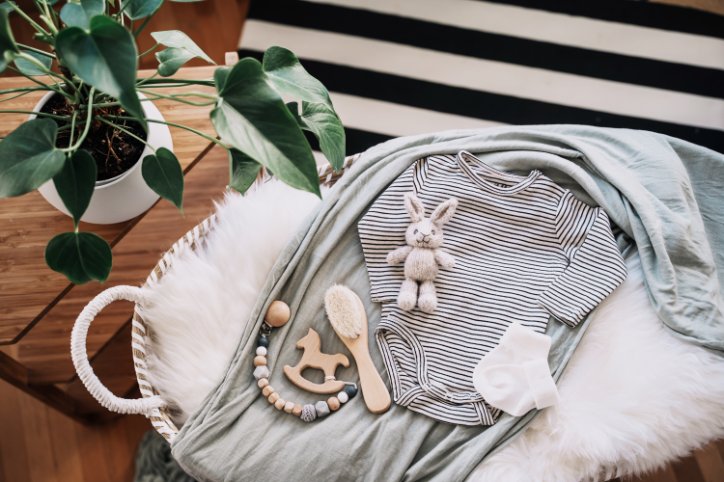
Sustainable baby clothing offers meaningful benefits for children and the planet. The choices parents make about newborn apparel can significantly impact both environmental health and babies’ wellbeing.
What’s Trending in Baby Clothes?
Top 2025 Trends Include:
- Plant-Based Dyes: Natural coloring from avocado skins, indigo, and turmeric
- Multi-Functional Designs: Convertible pieces that adapt as babies grow
- Smart Organic Fabrics: UV-protection and moisture-wicking in natural materials
- Gender-Neutral Palettes: Earth tones and pastels for versatile wardrobes
- Baby Athleisure: Organic cotton joggers and hoodies for active infants
Defining Sustainable Baby Clothing
Sustainable baby clothing refers to items made with eco-friendly materials and ethical manufacturing processes. Truly sustainable brands focus on using organic cotton, bamboo, hemp, or recycled fabrics that avoid harmful chemicals and pesticides.
These clothes are produced with minimal environmental impact through reduced water usage and carbon emissions. Many sustainable brands also ensure fair wages and safe working conditions for their workers.
Which Are the Main Trends When It Comes to Sustainability in Fashion?
The fashion industry is experiencing a major shift toward sustainability, with several key trends driving change:
- Circular Economy: Brands creating take-back programs and recycling initiatives
- Transparency: Supply chain visibility through QR codes and detailed sourcing information
- Local Production: Reducing carbon footprint through regional manufacturing
- Slow Fashion: Quality over quantity, with durable pieces built to last
- Plant-Based Materials: Innovation in organic and renewable fiber sources
What Is the Biggest Trend in Sustainability Right Now?
The biggest sustainability trend in 2025 is regenerative fashion – clothing that actively improves the environment rather than just minimizing harm. This includes fabrics made from recycled ocean plastic, carbon-negative materials, and farming practices that restore soil health.
Impact of Textile Waste on the Environment
The fashion industry creates enormous waste, with baby clothing contributing significantly due to rapid outgrowth. Textile production is one of the world’s largest polluters, using excessive water and harmful chemicals.
Traditional baby clothes often contain synthetic materials that don’t break down naturally and release microplastics when washed. A typical baby outgrows clothes within 2-3 months, potentially sending 280 items to landfills in just their first two years.
By choosing sustainable materials like organic cotton, parents reduce water usage by up to 91% compared to conventional cotton. Sustainable baby clothing helps break this cycle while protecting children from harmful substances.
Organic and Sustainable Fabrics in Newborn Fashion
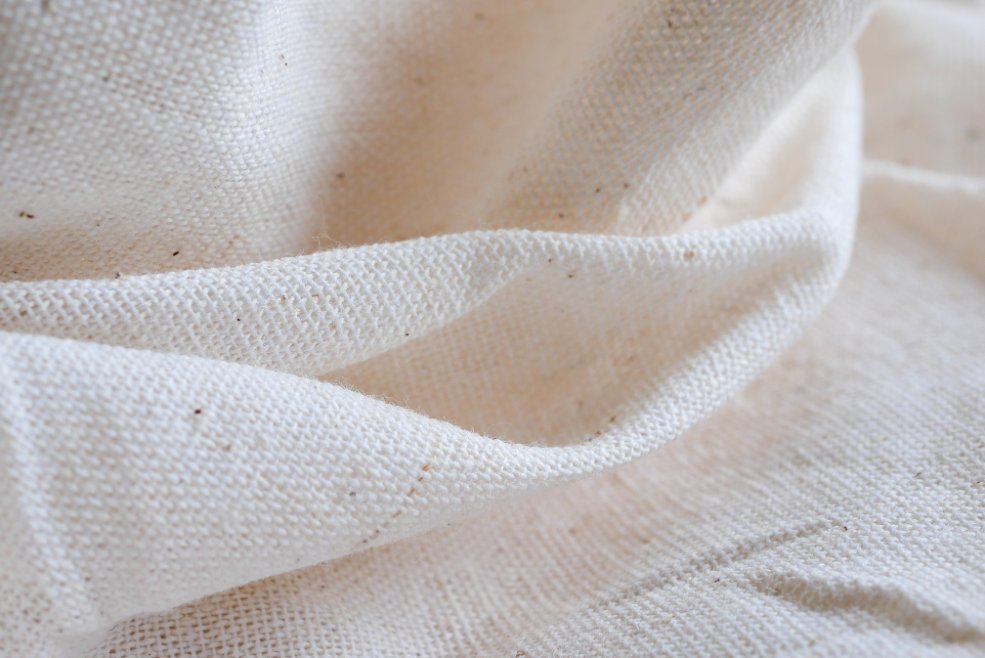
The fabric choices for newborn clothing have evolved significantly, with parents increasingly seeking materials that are gentle on baby’s skin and the environment. Sustainable textiles are revolutionizing how we dress our little ones.
Benefits of Organic Cotton and Bamboo Fabric
Organic Cotton stands as the gold standard for baby clothing. Unlike conventional cotton, it’s grown without harmful pesticides or synthetic fertilizers, making it ideal for a newborn’s sensitive skin and reducing the risk of irritation or allergic reactions.
GOTS Certified fabrics ensure the entire production process meets strict environmental and social standards. When shopping, always look for this certification to guarantee authenticity.
Why Are Bamboo Baby Clothes So Popular?
Bamboo Fabric Benefits:
- Naturally antibacterial and antifungal
- Highly breathable and moisture-wicking
- Incredibly soft, often compared to silk
- Hypoallergenic and gentle on sensitive skin
- Temperature regulating – cool in summer, warm in winter
- Grows rapidly without pesticides or excessive water
Is Bamboo Clothing Actually Sustainable?
Yes, bamboo clothing is genuinely sustainable when processed correctly. Bamboo grows 3-4 times faster than cotton, requires 70% less water, and naturally regenerates from its root system without replanting. However, the processing method matters – look for bamboo clothing processed with eco-friendly methods rather than harsh chemicals.
Is Bamboo or Cotton Better for Newborns?
| Feature | Organic Cotton | Bamboo |
|---|---|---|
| Softness | Very soft | Exceptionally soft |
| Breathability | Excellent | Superior |
| Durability | Very durable | Good durability |
| Antimicrobial | No | Yes, naturally |
| Water usage | Moderate (organic) | Very low |
| Temperature regulation | Good | Excellent |
What Are the Cons of Bamboo Clothing?
While bamboo has many benefits, there are some considerations:
- Can be more expensive than conventional cotton
- Some processing methods use chemicals (look for mechanical processing)
- May not be as durable as high-quality organic cotton
- Limited color options when using natural dyes
Innovative Materials: Tencel and Merino Wool
Tencel, made from sustainably sourced wood pulp, is revolutionizing newborn clothing. It feels silky-smooth against delicate skin while offering remarkable moisture management properties. Tencel blends are becoming increasingly popular in 2025 baby collections due to their durability and minimal environmental footprint.
Is Tencel Safe for Babies?
Yes, Tencel is exceptionally safe for babies. It’s made from natural wood fibers using a closed-loop production process that recycles 99% of chemicals and water. Tencel is naturally antibacterial, hypoallergenic, and biodegradable.
Merino Wool, despite common misconceptions, is perfect for babies. This fine, non-itchy wool is naturally temperature-regulating, odor-resistant, and biodegradable. It keeps babies warm in winter and cool in summer without the itchiness associated with traditional wool.
2025 Design Trends and Market Insights
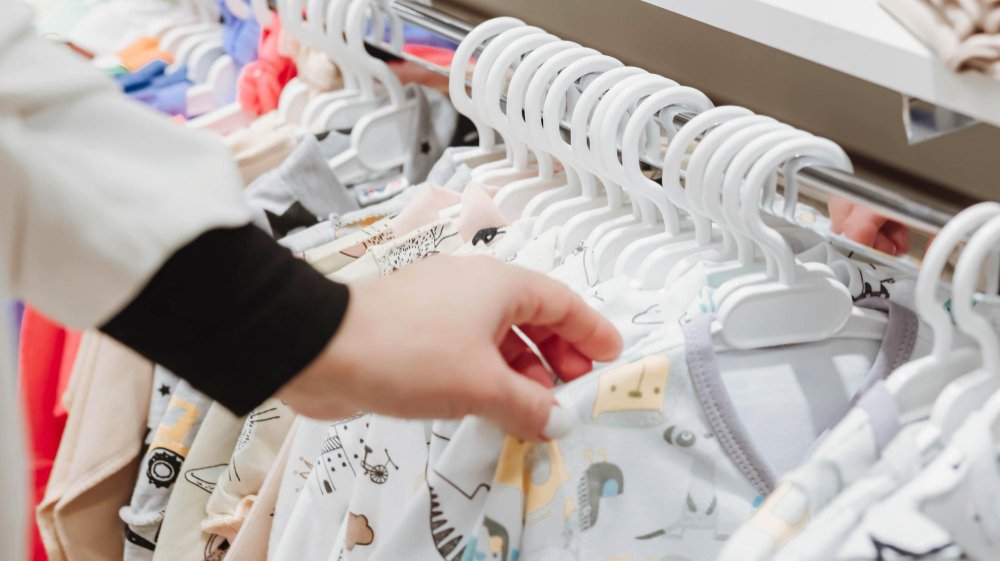
Sustainable newborn fashion is evolving with innovative design approaches that blend ethics with aesthetics. These trends emphasize versatility, longevity, and earth-friendly appeal while maintaining the cuteness factor parents love.
Market Insight: February 2025 marked a +97% increase in searches for seasonal infant jumpsuits and rompers, indicating strong demand for versatile, sustainable pieces that work across seasons.
Gender-Neutral Options and Minimalist Aesthetics
Gender-neutral designs have moved from niche to mainstream in sustainable baby fashion. More brands embrace simple silhouettes with relaxed fits that work for any baby. These pieces typically feature clean lines and functional details rather than overly decorative elements.
Earth tones dominate these collections, with soft beiges, gentle grays, and muted greens replacing traditional pink and blue. Brands are using organic cotton in kimono-style onesies and convertible garments that grow with the baby.
Incorporating Playful Animal Prints and Natural Tones
Animal prints are making a playful yet sophisticated statement in sustainable newborn fashion. Foxes, bears, and woodland creatures appear as subtle patterns on neutral backgrounds using earth-friendly dyes on organic fabrics.
Popular 2025 Color Palettes:
- Oatmeal and walnut brown
- Stone gray and sage green
- Natural ivory and terracotta
- Dusty rose and cream
- Soft lavender and mushroom gray
What Is H&M Doing for Sustainability?
H&M has made significant commitments to sustainability, including their 2022 launch of fully compostable baby clothing made from organic cotton. Their Conscious Collection uses organic and recycled materials, and they’ve introduced clothing take-back programs in stores worldwide. H&M aims to use 100% recycled or sustainably sourced materials by 2030.
Certifications and Standards for Sustainable Garments
Understanding certifications helps parents make informed choices when shopping for eco-friendly newborn clothing. These standards ensure clothes are made with safe materials and ethical practices.
Understanding the Global Organic Textile Standard (GOTS)
GOTS is the gold standard for organic clothing certification, tracking textiles from harvesting raw materials through manufacturing and labeling. For clothing to earn GOTS certification, it must contain at least 70% organic fibers and meet strict environmental criteria.
The standard prohibits harmful pesticides in cotton farming and toxic chemicals in processing. This matters greatly for newborn clothing since babies have sensitive skin and developing immune systems.
The Role of Certifications in Consumer Trust
Certifications like OEKO-TEX and Made Safe help bridge the gap between manufacturers’ claims and actual practices. These labels verify that products meet specific environmental and social standards through rigorous testing.
| Certification | Focus Area | What It Guarantees |
|---|---|---|
| GOTS | Organic textiles | 70%+ organic fibers, environmental & social criteria |
| OEKO-TEX Standard 100 | Chemical safety | No harmful substances detected |
| Cradle to Cradle | Circular design | Safe materials, renewable energy, social fairness |
| Fair Trade | Worker welfare | Fair wages, safe working conditions |
Essential Sustainable Baby Wear Items
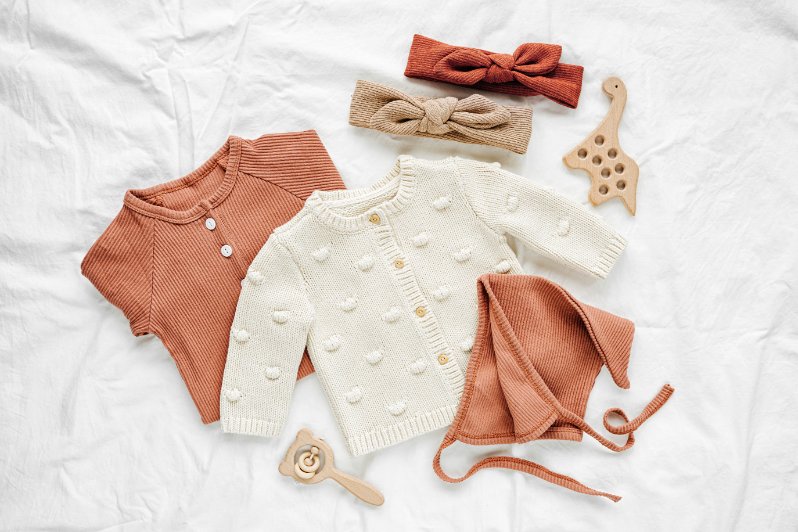
Building a sustainable wardrobe for your little one starts with a few key pieces that are versatile, durable, and made from earth-friendly materials. Focusing on high-quality organic items creates a foundation that’s better for your baby and the planet.
What Type of Outfit Is Best for a Newborn?
The best newborn outfits prioritize comfort, easy diaper access, and gentle materials. Onesies and bodysuits are ideal as base layers because they stay tucked in and provide easy diaper changes. Look for kimono-style tops that don’t require pulling over the head.
What Do Newborn Babies Wear the Most?
Newborns spend most of their time in:
- Onesies/Bodysuits: 8-10 needed for frequent changes
- Sleepers/Footies: 4-6 for day and night comfort
- Sleep sacks: 2-3 for safe sleeping
- Swaddles: 3-4 for better sleep
- Simple pants: 4-5 pairs with elastic waists
Must-Have Organic Baby Clothes
Essential Organic Baby Wardrobe:
- 8-10 organic cotton bodysuits in various styles
- 4-6 footed sleepers for day and night
- 4-5 pairs of stretchy pants with expandable waistbands
- 3-4 pairs of organic cotton or wool socks
- 2-3 cardigans or lightweight sweaters for layering
- 4-6 burp cloths made from organic cotton
- 2-3 organic cotton hats for temperature regulation
What Is the Rule for Newborn Clothes?
The golden rule for newborn clothes is “comfort and accessibility first.” Choose pieces with:
- Easy diaper access (snaps at the bottom)
- Wide necklines or kimono-style openings
- Soft seams that won’t irritate delicate skin
- No small buttons, bows, or choking hazards
- Natural, breathable fabrics
Should I Buy Newborn Size or 0-3 Months?
Most experts recommend buying more 0-3 month sizes than newborn. Many babies are born larger than newborn size (7+ pounds), and they grow quickly. A good ratio is:
- 30% newborn size
- 50% 0-3 months
- 20% 3-6 months
Understanding how different clothing types adapt as your baby grows can help you make smarter purchasing decisions. Our baby clothing size progression chart shows exactly how convertible and adaptive pieces work at each growth stage.
Which Fabric Is Best for a Newborn Baby?
Organic cotton remains the top choice for newborns due to its softness, breathability, and safety. Bamboo is another excellent option for its natural antibacterial properties and incredible softness. Avoid synthetic fabrics like polyester for newborns, as they can trap heat and moisture.
Layering with Eco-friendly Materials
Layering is key for regulating a baby’s temperature throughout the day. Start with a thin organic cotton onesie as the base layer that touches baby’s skin directly.
For middle layers, bamboo or hemp blend shirts and sweaters offer excellent temperature regulation. These materials are naturally antimicrobial and require less water to grow than conventional cotton.
Outer layers should be durable yet soft. Look for jackets made from organic wool, which is naturally water-resistant and temperature-regulating.
Top Sustainable Baby Clothing Brands and Shopping Guide
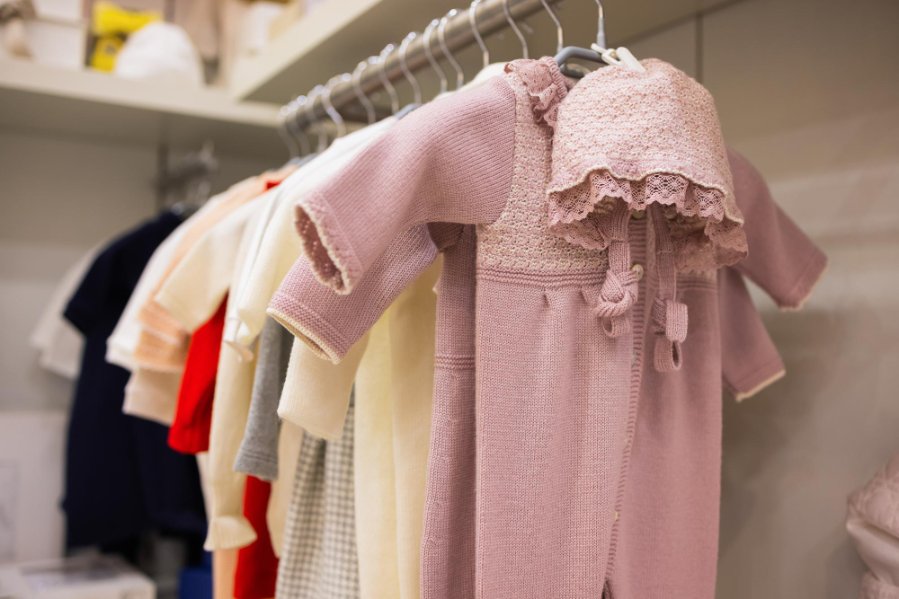
The sustainable baby clothing market has expanded dramatically, offering parents numerous options across different price points and styles. Here’s a comprehensive guide to making smart, sustainable choices.
What Is the Most Popular Brand of Baby Clothes?
While traditional brands like Carter’s dominate the overall market, sustainable favorites include:
- Colored Organics: GOTS-certified organic cotton basics
- Under the Nile: 100% organic Egyptian cotton
- L’ovedbaby: Organic cotton free from harmful chemicals
- Parade Organics: Sustainable designer essentials
- Little Green Radicals: Fair trade and organic options
For a detailed analysis of safety standards, certifications, and quality comparisons across sustainable baby clothing brands, check out our comprehensive safe baby clothing brands comparison guide.
Does M&S Do Baby Clothes?
Yes, Marks & Spencer offers an extensive baby clothing range through their “M&S Baby” line, including organic cotton options and their “Made for Me” sustainable collection. They’ve committed to using more sustainable materials and have introduced organic cotton basics at accessible price points.
Do Primark Do Baby Clothes?
Primark offers baby clothing through their children’s section, though their focus is primarily on affordable fast fashion rather than sustainability. For eco-conscious parents, budget-friendly sustainable baby clothes are available through specialty retailers that prioritize both affordability and environmental responsibility.
Does TK Maxx Do Baby Clothes?
TK Maxx (T.J. Maxx in the US) carries baby clothes in their children’s sections, often featuring discounted designer and brand-name items. While they occasionally stock sustainable brands, their inventory varies by location and season.
What Is Kyte Baby Material?
Kyte Baby specializes in bamboo rayon clothing, known for its incredible softness and temperature-regulating properties. Their signature bamboo fabric is naturally hypoallergenic, moisture-wicking, and gentle on sensitive skin.
What Is the Kyte Baby Controversy?
The Kyte Baby controversy arose in 2024 when the company faced criticism for their handling of a maternity leave situation. While this affected their brand reputation, it wasn’t related to their product quality or sustainability practices.
Is Kyte Baby Sustainable?
Kyte Baby’s bamboo rayon is considered relatively sustainable due to bamboo’s fast growth and low water requirements. However, the rayon processing involves chemicals, making it less eco-friendly than mechanically processed bamboo or organic cotton. They’re working toward more sustainable practices but aren’t certified organic.
Sustainability Shopping Calculator
Quick Guide to Sustainable Baby Clothing Costs:
| Item Type | Conventional Price | Sustainable Price | Cost per Wear |
|---|---|---|---|
| Organic Cotton Onesie | $8-12 | $14-22 | $0.50-0.75 |
| Bamboo Sleeper | $15-20 | $25-35 | $0.80-1.20 |
| Organic Cotton Pants | $10-15 | $18-28 | $0.60-0.90 |
Sustainable items typically last 40-60% longer and can be passed down to siblings
Maintaining the Integrity of Organic Materials
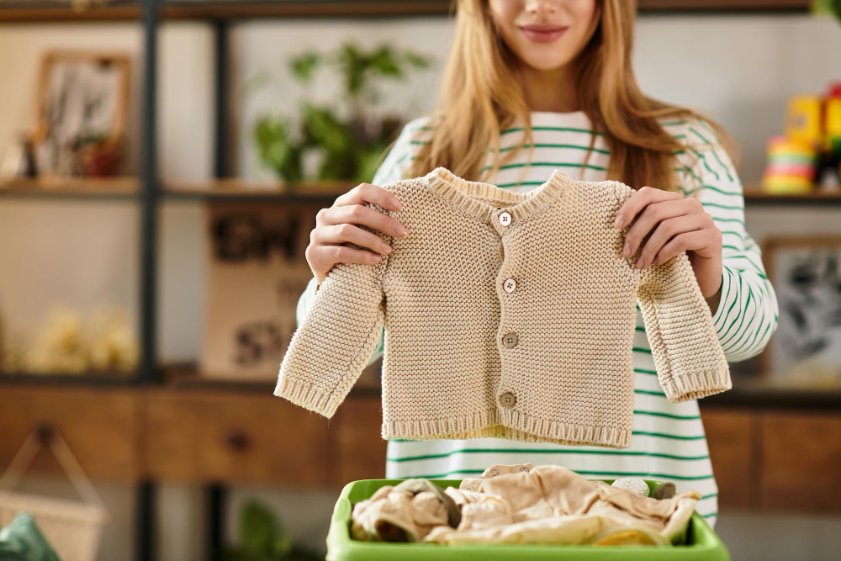
Caring for sustainable baby clothing requires specific approaches to preserve their quality and extend their lifespan. Organic fabrics have different needs than conventional materials due to their natural properties and absence of chemical treatments.
Care Tips for Sustainable Baby Clothing
Washing organic baby clothes in cold water helps maintain fiber integrity and prevents shrinkage. Use plant-based, fragrance-free detergents specifically formulated for sensitive skin to avoid irritating your baby while preserving fabric quality.
Avoid bleach and fabric softeners as they contain harsh chemicals that break down organic fibers and negate the benefits of choosing sustainable clothing. Instead, try natural alternatives:
Natural Fabric Care Solutions:
- White vinegar (1/4 cup per load) as a natural fabric softener
- Baking soda (1/2 cup) to brighten whites naturally
- Lemon juice to remove tough stains without chemicals
- Cold water washing to preserve colors and fibers
- Air-drying to extend garment life significantly
What Should a Baby Wear to Bed?
For safe sleep, babies should wear lightweight, breathable sleepwear. Organic cotton sleep sacks are ideal as they eliminate loose blankets while maintaining warmth. Choose sleep sacks with the appropriate TOG rating for room temperature.
What Tog Sleeping Bag for Baby?
TOG ratings help determine appropriate sleepwear thickness:
- 0.5 TOG: Room temperature above 24°C (75°F)
- 1.0 TOG: Room temperature 21-24°C (70-75°F)
- 2.5 TOG: Room temperature 16-21°C (61-70°F)
- 3.5 TOG: Room temperature below 16°C (61°F)
Longevity and Repair of Eco-friendly Garments
Quality sustainable baby clothing is designed to last through multiple children. Many brands create adjustable features such as fold-over waistbands and cuffs that grow with your baby.
Learning basic mending skills can drastically extend garment life. Simple techniques worth mastering include hand-stitching small tears, patching worn areas with leftover organic fabric, and reinforcing seams that show early signs of wear.
When outgrown, sustainable baby clothes retain resale value better than conventional alternatives. Create a circular system by selling or donating items to extend their useful life.
Smart Shopping Strategies for Sustainable Baby Fashion
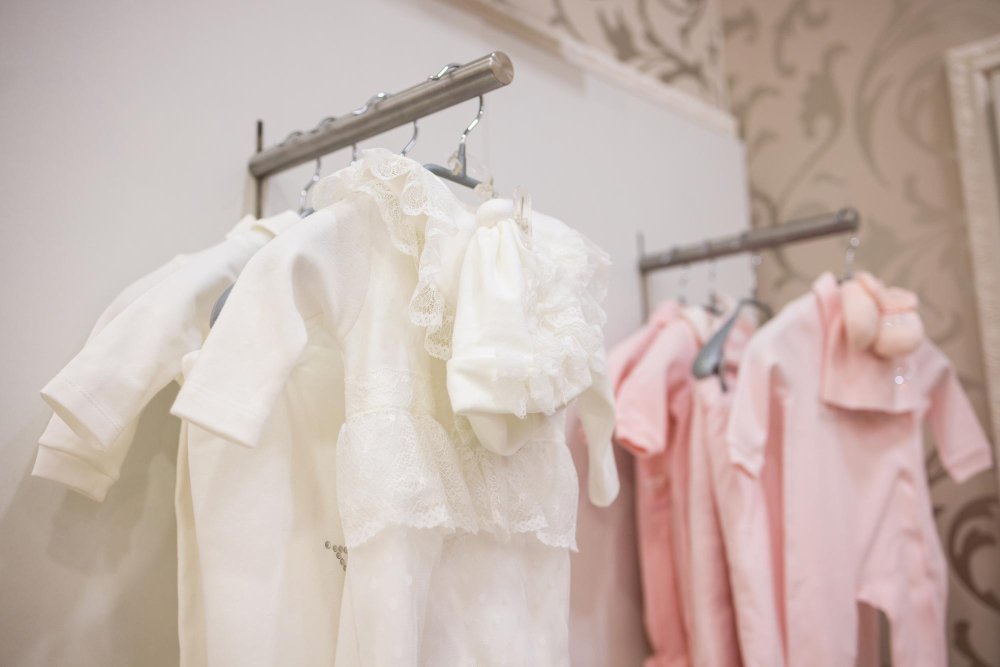
How Many Outfits Do Newborns Wear a Day?
Newborns typically go through 2-4 outfit changes daily due to feeding, diaper leaks, and spit-up. This means you’ll need:
- 8-10 onesies for daily rotation
- 4-6 pairs of pants or leggings
- 6-8 sleepers for day and night
- Extra clothes for unexpected changes
Should I Buy a Lot of Newborn Clothes?
Avoid buying too many newborn-sized items since babies grow quickly. Focus on purchasing quality pieces in 0-3 month sizes, which most babies wear longer. Sustainable options cost more upfront but offer better value through durability and resale potential.
What Size Do Babies Wear the Longest?
Babies typically wear 3-6 month and 6-9 month sizes the longest, as growth slows slightly after the initial rapid newborn phase. Investing in higher-quality sustainable pieces in these sizes provides the best value.
How to Dress a Newborn in Summer from the Hospital?
For summer hospital discharge, choose breathable organic cotton pieces:
- Lightweight organic cotton onesie
- Thin cotton pants or shorts
- Sun hat made from organic materials
- Light blanket for air conditioning
- Soft organic cotton socks
What Are the 3 R’s of Sustainable Fashion?
The three R’s guide sustainable fashion choices:
- Reduce: Buy fewer, higher-quality pieces
- Reuse: Pass clothes between siblings, buy secondhand
- Recycle: Donate, sell, or properly dispose of worn items
Budget-Friendly Sustainable Shopping Tips
Sustainable doesn’t have to mean expensive. Here are strategies for conscious parents on any budget:
🎯 Plan Your Sustainable Baby Clothing Budget
Ready to create a realistic budget for your eco-friendly baby wardrobe? Our baby clothing budget planner provides personalized cost breakdowns and shopping priorities based on your specific needs and budget range.
Money-Saving Sustainable Strategies:
- Join clothing swaps with other parents
- Shop end-of-season sales for organic brands
- Look for gently used sustainable pieces
- Invest in convertible pieces that grow with baby
- Choose gender-neutral colors for future siblings
- Buy basics in bulk from organic brands
- Sign up for sustainable brand newsletters for exclusive discounts
What Color Do Newborns Look Best In?
Newborns look beautiful in soft, muted colors that complement their delicate features. Popular choices include:
- Cream and ivory tones
- Soft pastels (mint, blush, lavender)
- Natural earth tones (oatmeal, sage, mushroom)
- Classic white for timeless photos
These colors also photograph beautifully and work well for gender-neutral styling.
Ethical Production and Working Conditions
The fashion industry is transforming how baby clothes are made, with companies now focusing on treating workers fairly and being transparent about their manufacturing processes.
Ensuring Fair Labor Practices
Fair wages are crucial in ethical baby fashion. When researching brands, look for those that pay workers living wages rather than just minimum wage. Many sustainable newborn clothing companies now provide wages that allow workers to support their families adequately.
Safe working environments are equally important. Ethical manufacturers ensure proper ventilation, reasonable working hours, and protection from harmful chemicals used in textile production.
Transparency in the Supply Chain
Transparent production allows parents to trace where baby clothes come from. More brands now share details about their factories and production methods on their websites.
QR codes on baby clothing tags are becoming common in 2025. These codes let parents scan and see exactly where materials were sourced and which facilities made the garment.
Key Transparency Markers to Look For:
- Published factory lists with locations
- Wage information and worker benefits
- Third-party audits and certifications
- Direct farmer relationships for cotton sourcing
- Environmental impact reports
The Future of Sustainable Newborn Fashion
Sustainable newborn fashion will continue evolving significantly in the coming years. Brands are increasingly focusing on eco-friendly materials that are both gentle on baby skin and the environment.
Organic cotton remains a frontrunner in this movement. Major retailers are creating baby clothes made from organic cotton that can be fully composted when no longer needed, representing a true circular economy approach.
Technology and Innovation
Technological innovations are advancing sustainable practices:
- Smart Fabrics: Organic materials with UV protection and temperature regulation
- 3D Knitting: Zero-waste production methods
- Plant-Based Dyes: Colors derived from food waste and natural sources
- Blockchain Tracking: Complete supply chain transparency
Future Market Projections
Emerging Materials and Trends
| Material | Source | Benefits | Availability |
|---|---|---|---|
| Organic Cotton | Pesticide-free cotton plants | Soft, durable, biodegradable | Widely available |
| Bamboo Fiber | Rapidly renewable bamboo | Antibacterial, moisture-wicking | Increasingly common |
| Recycled Cotton | Post-consumer textile waste | Reduces waste, familiar feel | Growing availability |
| Hemp | Industrial hemp plants | Durable, naturally antimicrobial | Limited but growing |
Frequently Asked Questions
Check materials first – look for organic cotton, bamboo, or hemp grown without harmful pesticides. Shop from brands that openly share their manufacturing processes and look for certifications like GOTS or OEKO-TEX. Consider secondhand options, as baby clothes are typically worn for just a few months.
Organic materials contain fewer harmful chemicals that might irritate a newborn’s sensitive skin, reducing the risk of rashes and allergic reactions. They’re grown without synthetic pesticides and fertilizers, making them safer for babies who often put clothing in their mouths. The production process also uses less water and supports soil health.
GOTS (Global Organic Textile Standard) is the most respected certification, ensuring both ecological and social criteria are met. OEKO-TEX Standard 100 certifies that textiles have been tested for harmful substances. Fair Trade certification ensures fair wages and safe working conditions, while B Corp certification indicates high social and environmental standards.
Look for multipurpose designs that can be worn longer and convertible garments that adjust as babies grow. Check durability of fabrics and construction – reinforced seams and quality materials will withstand multiple washes. Seek brands with take-back programs or recycling initiatives to close the loop in clothing’s lifecycle.
Both are excellent choices with different strengths. Organic cotton is more durable and widely available, while bamboo is softer, naturally antibacterial, and better at moisture-wicking. Bamboo grows faster and uses less water, making it more environmentally sustainable. The choice often comes down to personal preference and specific needs.
Yes, bamboo clothes are safe for babies when properly processed. Look for bamboo clothing that’s mechanically processed rather than chemically processed. Bamboo is naturally hypoallergenic, antibacterial, and gentle on sensitive skin. It’s also temperature-regulating, helping keep babies comfortable.
Absolutely. Bamboo is a natural, biodegradable material that doesn’t contain harmful chemicals like BPA or phthalates found in some plastics. It’s renewable, grows quickly without pesticides, and breaks down naturally at end of life, unlike plastic which can persist in the environment for hundreds of years.
Yes, bamboo sleepsuits are excellent for babies. They’re naturally temperature-regulating, keeping babies comfortable throughout the night. The moisture-wicking properties help prevent overheating, while the antibacterial qualities reduce odors. The incredible softness is gentle on delicate skin during long sleep periods.
Extended use significantly reduces environmental impact – each additional month a garment remains in use decreases its carbon footprint. Quality sustainable clothes that last can be passed down to siblings or other families, multiplying the sustainability benefits. Biodegradable materials return to earth without harm, while synthetic fabrics may persist in landfills for decades.
H&M baby clothes meet European safety standards and are generally considered safe. Their Conscious Collection uses organic and recycled materials with fewer chemicals. However, for maximum safety and sustainability, look for their GOTS-certified organic pieces or consider specialized organic baby clothing brands.
Conclusion
The sustainable newborn fashion landscape in 2025 offers unprecedented opportunities for conscious parenting. With the global organic baby clothing market reaching $3.39 billion and growing at 6.67% annually, sustainable options are more accessible, affordable, and stylish than ever before.
Essential Recommendations for Parents
Action Steps for Sustainable Baby Fashion:
- Start with certified basics: Invest in GOTS-certified organic cotton onesies and sleepers as your foundation
- Choose quality over quantity: Fewer, well-made pieces last longer and provide better value
- Embrace versatility: Select gender-neutral, convertible designs that grow with your baby
- Research brands thoroughly: Look for transparency in supply chains and ethical production practices
- Care properly: Use gentle, eco-friendly washing methods to extend garment life
- Think circular: Plan for resale, donation, or hand-me-downs from the beginning
The Future is Sustainable
As 67% of millennial parents now prioritize sustainability in their purchasing decisions, the industry continues evolving to meet this demand. Innovations in plant-based dyes, smart organic fabrics, and circular economy practices are making sustainable baby fashion the new standard rather than a niche choice.
Budget-Conscious Sustainability
Sustainable baby clothing has become surprisingly affordable, with prices decreasing 40% over the past three years. When calculated per wear and considering resale value, sustainable options often cost less than conventional alternatives while providing superior comfort and safety for your baby.
Making a Difference
Every sustainable clothing choice contributes to a healthier planet for our children. By choosing organic materials, parents reduce water usage by up to 91%, eliminate harmful pesticides from production, and support fair labor practices worldwide.
The transition to sustainable newborn fashion isn’t just about clothes – it’s about creating a better world for the next generation. With options ranging from budget-friendly basics to luxury organic pieces, every family can participate in this positive change.
As we move forward in 2025, sustainable baby fashion represents more than a trend – it’s a fundamental shift toward conscious consumerism that prioritizes both child health and environmental stewardship. The choices made today in your baby’s wardrobe will contribute to a more sustainable fashion industry tomorrow.

